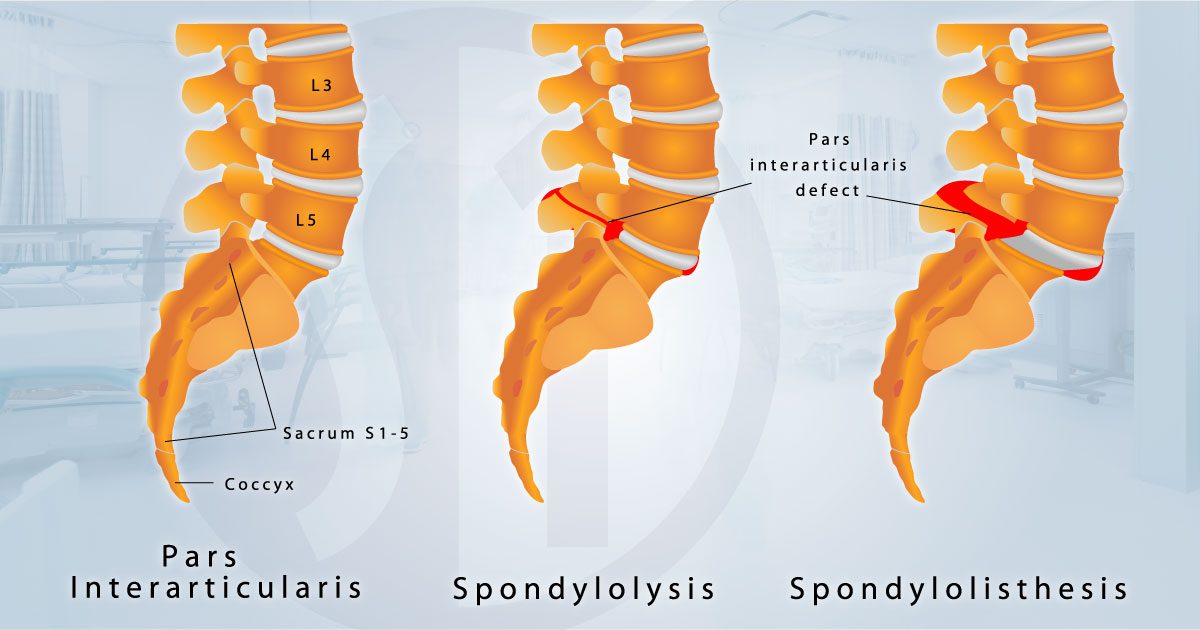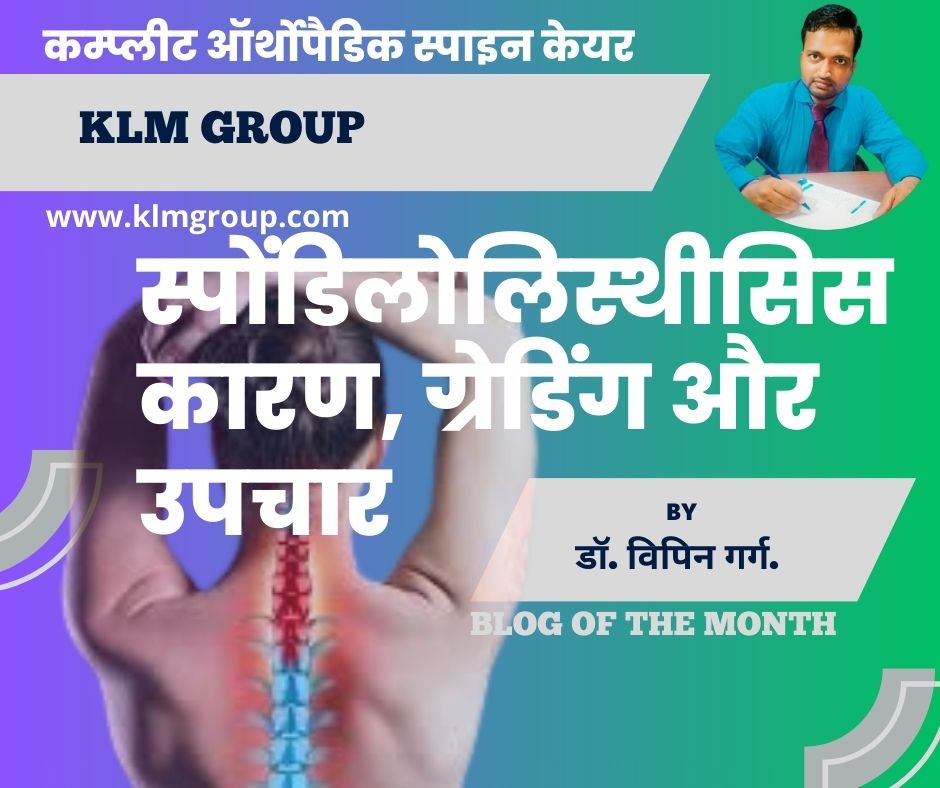Spondylolisthesis Causes, Grading, and Treatment Options: Spondylolisthesis is a condition that affects the spine, causing one of the vertebrae to slip out of place onto the bone below it. This misalignment can lead to pain, nerve compression, and other debilitating symptoms. Understanding the causes, grading, and treatment options for spondylolisthesis is crucial for managing the condition effectively. In this blog, we will delve into these aspects, with insights from Dr. Vipin Garg and the KLM Group, who provide specialized care for spinal conditions. We can see more details about “Spondylolisthesis Causes” in this blog.

What is Spondylolisthesis?
Spondylolisthesis occurs when a vertebra slips forward or backward relative to the vertebrae below it. This condition can occur at any level of the spine but is most common in the lumbar (lower back) region. The slippage can lead to spinal instability, pain, and potential nerve compression. We can see some more details about “Spondylolisthesis Causes” in this blog.

Types of Spondylolisthesis
- Congenital Spondylolisthesis: This type is present at birth and results from abnormal bone formation in the spine.
- Isthmic Spondylolisthesis: Caused by a defect in a part of the vertebra called the pars interarticularis, which often results from stress fractures.
- Degenerative Spondylolisthesis: Common in older adults, it results from the wear and tear of the spinal discs and joints.
- Traumatic Spondylolisthesis: Occurs due to direct trauma or injury to the spine, leading to vertebral slippage.
- Pathologic Spondylolisthesis: Caused by a disease or condition that weakens the spine, such as osteoporosis or a tumor.
- Post-Surgical Spondylolisthesis: Develops after spinal surgery when the spine becomes unstable.
Causes of Spondylolisthesis
Several factors can contribute to the development of spondylolisthesis, including:
- Genetics: A family history of spinal conditions can increase the risk.
- Age: Degenerative changes in the spine are more common with aging.
- Repetitive Stress: Activities that involve repetitive extension and flexion of the spine can lead to stress fractures.
- Trauma: Direct injury to the spine can cause vertebral slippage.
- Bone Diseases: Conditions like osteoporosis can weaken the spine and increase the risk of spondylolisthesis.
Grading of Spondylolisthesis
Spondylolisthesis is graded based on the degree of vertebral slippage. The most commonly used grading system is the Meyerding classification, which divides the condition into five grades:
- Grade I: 1-25% slippage
- Grade II: 26-50% slippage
- Grade III: 51-75% slippage
- Grade IV: 76-100% slippage
- Grade V (Spondyloptosis): The vertebra has completely fallen off the vertebra below it.

Grading helps in determining the severity of the condition and the appropriate treatment approach.
Symptoms of Spondylolisthesis
The symptoms of spondylolisthesis can vary depending on the severity of the slippage and the affected spinal level. Common symptoms include:
- Lower Back Pain: Pain in the lower back is the most common symptom, often worsening with activity and improving with rest.
- Sciatica: Pain that radiates down one or both legs, often due to nerve compression.
- Stiffness: Reduced flexibility and stiffness in the lower back.
- Muscle Tightness: Tightness or spasms in the hamstrings and buttocks.
- Numbness and Tingling: Sensations of numbness or tingling in the legs or feet.
- Weakness: Muscle weakness in the lower extremities.
Diagnosis of Spondylolisthesis
Diagnosing spondylolisthesis typically involves a combination of medical history, physical examination, and imaging studies.

Medical History and Physical Examination
The doctor will begin by taking a detailed medical history, asking about symptoms, activity levels, and any history of spinal conditions or injuries. During the physical examination, the doctor will assess the range of motion, flexibility, and areas of pain or tenderness in the spine. We can find more details about “Spondylolisthesis Causes” in this blog.
Imaging Studies
- X-rays: Standard X-rays can show the alignment of the vertebrae and the degree of slippage.
- MRI (Magnetic Resonance Imaging): An MRI provides detailed images of the soft tissues, including the spinal discs and nerves, helping to identify nerve compression or other abnormalities.
- CT Scan (Computed Tomography): A CT scan offers detailed cross-sectional images of the spine, useful for evaluating the bone structures and detecting fractures.
Conservative Treatment Options for Spondylolisthesis
Most cases of spondylolisthesis can be managed with conservative, non-surgical treatments. These approaches aim to relieve pain, improve function, and prevent further slippage.

Physical Therapy
Physical therapy plays a crucial role in the management of spondylolisthesis. A physical therapist can design a personalized exercise program to:
- Strengthen Core Muscles: Strong core muscles provide better support for the spine and reduce the strain on affected vertebrae.
- Improve Flexibility: Stretching exercises can help maintain flexibility and reduce muscle tightness.
- Enhance Posture: Proper posture can alleviate pressure on the spine and improve overall spinal alignment.
- Educate on Body Mechanics: Learning how to move and lift correctly can prevent further injury.
Medications
- Nonsteroidal Anti-Inflammatory Drugs (NSAIDs): Medications like ibuprofen or naproxen can help reduce inflammation and relieve pain.
- Muscle Relaxants: These medications can alleviate muscle spasms and tightness.
- Pain Relievers: Over-the-counter pain relievers like acetaminophen can be used for pain management.
Bracing
In some cases, wearing a back brace can help stabilize the spine and reduce pain by limiting movement and providing support.
Injections
- Epidural Steroid Injections: Corticosteroid injections into the epidural space can reduce inflammation and alleviate pain, particularly in cases of nerve compression.
- Facet Joint Injections: Injections into the facet joints can provide pain relief if these joints are contributing to the pain. We can check more details about “Spondylolisthesis Causes” in this blog.
Surgical Treatment Options for Spondylolisthesis
Surgery is considered when conservative treatments fail to provide relief or if the slippage is severe and causing significant nerve compression or instability. The goal of surgery is to relieve pain, stabilize the spine, and prevent further slippage.
Types of Surgical Procedures
- Spinal Fusion: This is the most common surgical procedure for spondylolisthesis. It involves fusing the affected vertebrae to prevent further slippage and provide stability. Bone grafts or metal rods and screws may be used to support the fusion.
- Decompression: Also known as laminectomy, this procedure involves removing part of the vertebra or other structures pressing on the nerves to relieve nerve compression.
- Combined Procedures: In some cases, both fusion and decompression may be performed together to achieve the best results.
Recovery and Rehabilitation
Recovery from surgery varies depending on the type and extent of the procedure. Post-operative rehabilitation is crucial for successful recovery and includes:
- Physical Therapy: A structured rehabilitation program to regain strength, flexibility, and mobility.
- Activity Modification: Gradual return to normal activities, avoiding heavy lifting and strenuous activities during the initial recovery period.
- Follow-Up Care: Regular follow-up appointments with the surgeon to monitor healing and progress.
Read More:
Expert Care at KLM Group
Dr. Vipin Garg
Dr. Vipin Garg is a renowned orthopedic specialist with extensive experience in diagnosing and treating spinal conditions, including spondylolisthesis. His expertise ensures that patients receive the highest quality care tailored to their specific needs. We will see more details about “Spondylolisthesis Causes” in this blog.
Services Offered by KLM Group
Comprehensive Evaluation: Detailed assessments to identify the root cause of pain and dysfunction.
Physical Therapy: Personalized exercise programs, manual therapy, and patient education to improve mobility, strength, and function.
Pain Management: Multidisciplinary approach to managing pain through non-surgical treatments, medication, and lifestyle modifications.
Surgical Interventions: Advanced surgical procedures for severe cases of spondylolisthesis, performed by experienced orthopedic surgeons.
Patient Education: Guidance on posture, ergonomics, and exercises to prevent injury recurrence.
Conclusion
Spondylolisthesis is a condition that requires careful diagnosis and a tailored treatment approach. With a combination of conservative treatments and, if necessary, surgical interventions, most patients can achieve significant pain relief and improved function.
Whether you are dealing with mild symptoms or severe slippage, the KLM Group, led by Dr. Vipin Garg, provides expert care to support your journey to better spinal health. Their comprehensive services and personalized treatment plans ensure that you receive the most effective care for your condition. We will see more details about “Spondylolisthesis Causes” in this blog.
Contact KLM Group:
- Book Your Consultation
- Website: https://tinyurl.com/yyzvwmck
- Email: info@klmgrou p.orgPh: 0751-4000721,Mob: 7804826825
Address Link: https://g.page/r/CQ0WqKLEXPWeEAE Powered By Argusdna Also for the best, Orthopedic doctor and surgeon in Kolkata visit www.bonedoctorgautam.com
Take the first step towards a healthier, pain-free life by consulting with the experts at KLM Group. Their dedicated team is here to help you achieve your health goals and improve your quality of life.

